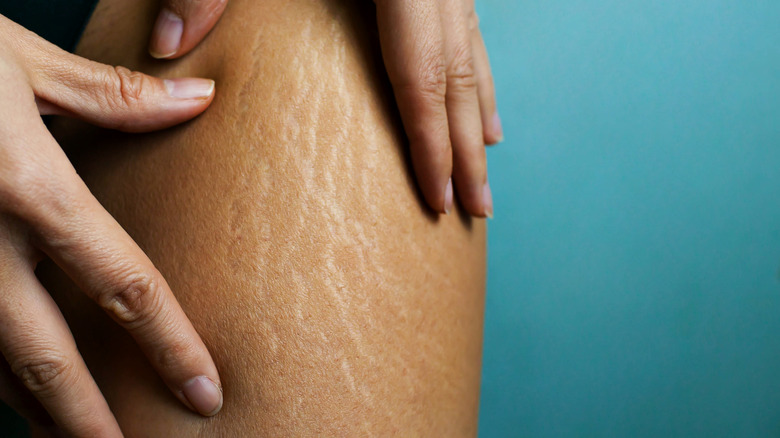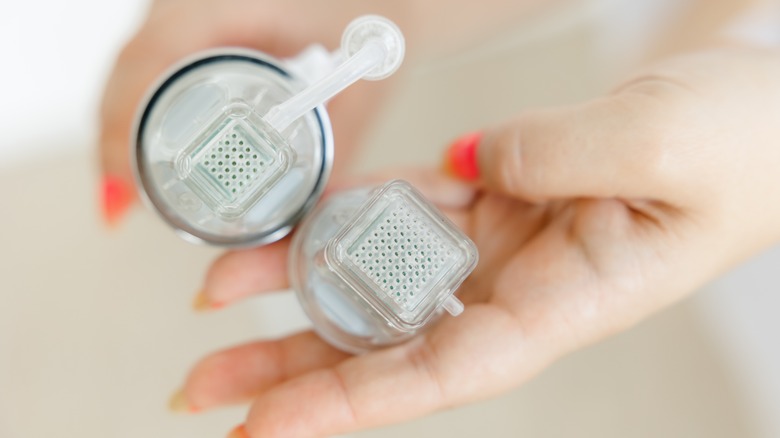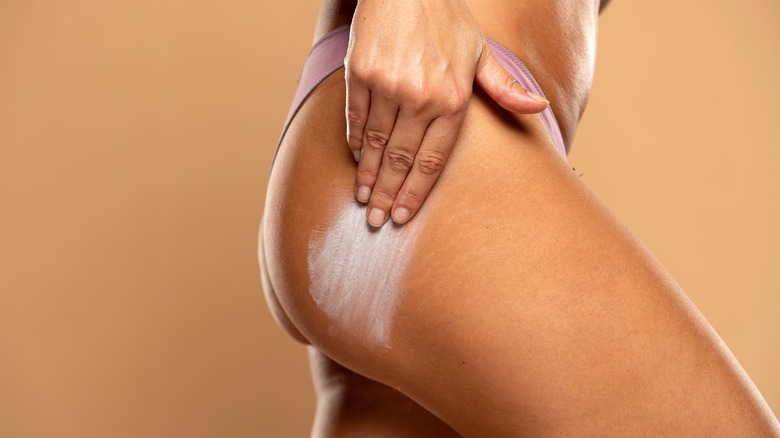How Microneedling May Help With Stretch Marks
There are a whole host of creams and treatments out there that claim to prevent or reduce the appearance of stretch marks, but their efficacy is unpredictable, meaning that many are left with pink or purplish indented streaks on various parts of the body. Over time, they usually fade to a pearly-white or gray tone.
This phenomenon happens when the skin is stretched out or shrinks too quickly. When this occurs, the elastin and collagen in the skin rupture, leaving a groove-like band, says the American Academy of Dermatology. Often, these marks appear on the thighs, belly, and buttocks.
Some people are simply more prone to stretch marks. Most people who get them are women, and 50% to 90% of pregnant people will wind up with stretch marks to some extent, Cleveland Clinic explains. Scientists also believe that certain people are genetically predisposed, but also point out that the degree of stress on the skin is going to affect how bad the marks get. For example, someone who carries triplets nearly to term is likely to have more and deeper stretch marks than a woman who delivers only one baby because the stomach skin is stretched out so much more. People who are most likely to develop stretch marks, other than pregnant women, are those who experience large growth spurts in puberty, gain or lose weight very quickly, or otherwise go through a dramatic and fast physical change, per Mayo Clinic.
How does microneedling get rid of stretch marks?
Some people see stretch marks as a badge of honor, but others aren't pleased with the change in their physical appearance. Now, microneedling is emerging as a treatment that can restore the skin to its original look, or at least come pretty close.
You've probably already heard that microneedling involves using itty-bitty needles to penetrate the top layer of the skin. The idea is that microneedling causes minor damage to the dermis, which then incites the body to make more elastin and collagen to heal the area, per Sculpt MD. So, the microneedling gives the skin the opportunity to renew depleted supplies because it penetrates deep enough to spur healing throughout the entire area.
Sculpt MD says that it can take four to six months (three to six treatments) to achieve the desired results, depending on how significant the stretch marks are. Each treatment is about 30 minutes long. Microneedling may not result in the complete removal of the marks, but it should drastically reduce their appearance.
Alternatives to microneedling for stretch marks
Stretch marks aren't just a cosmetic issue. They can also get pretty itchy and irritated, so it's no wonder that some people are keen to have them excommunicated. However, Cleveland Clinic says the microneedling process itself can actually cause skin flakes, irritation, swelling, and discoloration, so things might get worse before they get better.
Microneedling is a great relative newcomer to the stretch mark removal game, but it's also pretty pricey. Although there is sure to be some variation depending on the clinic where it's done, Healthline estimates that each treatment ranges from $200 to $700, meaning that a round of treatments can come in at a steep total of $600 to $4,200.
Obviously, a lot of people don't have that kind of coin to spend on what's primarily an aesthetic issue. Some people turn to over-the-counter retinol products to get stretch mark-banishing results, although it can take six months or more to really notice a difference. Other options for home care include applying aloe vera gel or hyaluronic acid on a daily basis to reduce stretch mark appearance. If none of those work and you still want to say bye-bye to stretch marks, it could be time to turn to microneedling or another higher-grade solution (like laser skin resurfacing or dermabrasion) to get the job done.


